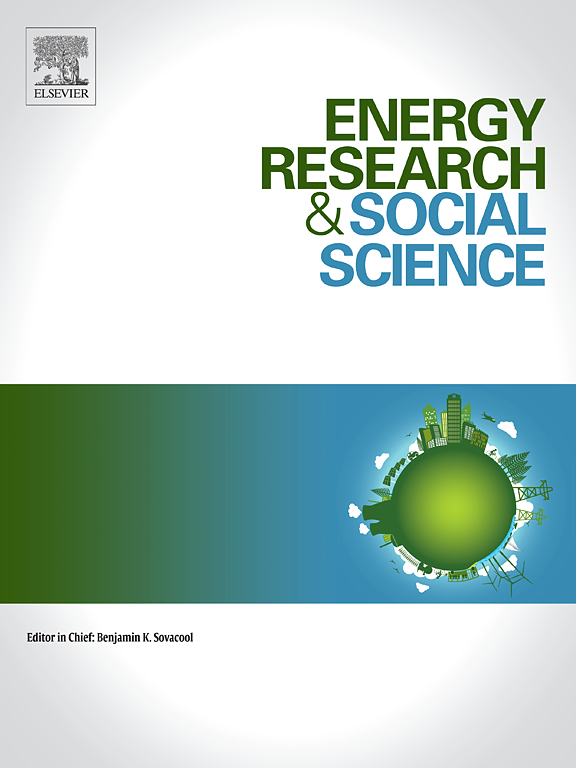直接空气碳捕获和储存的感知利益和障碍:使用结构方程模型在德国公民中应用整体视角
IF 7.4
2区 经济学
Q1 ENVIRONMENTAL STUDIES
引用次数: 0
摘要
直接空气碳捕获和储存(DACCS)等技术旨在通过从大气中捕获二氧化碳并将其储存在地质构造中来减少大气中的温室气体。公众的接受在成功实施可持续技术方面起着关键作用。因此,本研究通过对德国lay样本(N = 908)进行的在线调查,调查了影响DACCS接受程度的因素。利用偏最小二乘结构方程模型,我们研究了DACCS、直接空气捕获(DAC)和碳捕获与封存(CCS)的感知,以研究影响技术感知的因素及其对DACCS接受度的影响,以及与人相关的特征。研究结果显示,DAC比CCS和DACCS在情感和认知上(即感知到的好处和障碍)都更积极。对DACCS的接受程度一般。结构模型表明,DACCS的接受程度直接受到对其利益和障碍的看法以及性别和教育等特征的影响。参与者的情感评价和对创新的开放程度间接影响接受度。DAC、CCS和DACCS的分割强调了技术感知与它们各自对技术接受的影响之间的关系。这项研究有助于更深入地了解公众接受的心理和社会驱动因素,并强调在沟通和政策设计中需要考虑二氧化碳去除技术的个别组成部分和综合性质。调查结果强调了公众的看法在确定大规模实施DACCS的可行性方面的重要性。本文章由计算机程序翻译,如有差异,请以英文原文为准。
Perceived benefits and barriers of direct air carbon capture and storage: Applying a holistic perspective among German citizens using structural equation modeling
Technologies such as Direct Air Carbon Capture and Storage (DACCS) are designed to reduce atmospheric greenhouse gases by capturing carbon dioxide from the atmosphere and storing it in geological formations. Public acceptance plays a critical role in the successful implementation of sustainable technologies. This study therefore investigates which factors influence the acceptance of DACCS through an online survey conducted with a German lay sample (N = 908). Using Partial Least Squares Structural Equation Modeling, we examine the perception of DACCS, Direct Air Capture (DAC), and Carbon Capture and Storage (CCS) to examine the factors contributing to technology perception and the influence they have on DACCS acceptance, along with person-related characteristics.
The findings reveal that DAC is viewed more positively than CCS and DACCS, both affectively and cognitively (i.e., perceived benefits and barriers). Acceptance of DACCS is moderate. The structural model indicates that DACCS acceptance is directly shaped by perceptions of its benefits and barriers, and by characteristics such as gender and education. Participants’ affective evaluations and openness to innovation indirectly influence acceptance. The segmentation of DAC, CCS, and DACCS emphasizes the relationship between technology perceptions and their respective influence on technology acceptance.
This study contributes to a deeper understanding of the psychological and social drivers of public acceptance and highlights the need to consider both the individual components and the composite nature of CO2 removal technologies in communication and policy design. The results underscore the importance of public perceptions in shaping the feasibility of implementing DACCS at scale.
求助全文
通过发布文献求助,成功后即可免费获取论文全文。
去求助
来源期刊

Energy Research & Social Science
ENVIRONMENTAL STUDIES-
CiteScore
14.00
自引率
16.40%
发文量
441
审稿时长
55 days
期刊介绍:
Energy Research & Social Science (ERSS) is a peer-reviewed international journal that publishes original research and review articles examining the relationship between energy systems and society. ERSS covers a range of topics revolving around the intersection of energy technologies, fuels, and resources on one side and social processes and influences - including communities of energy users, people affected by energy production, social institutions, customs, traditions, behaviors, and policies - on the other. Put another way, ERSS investigates the social system surrounding energy technology and hardware. ERSS is relevant for energy practitioners, researchers interested in the social aspects of energy production or use, and policymakers.
Energy Research & Social Science (ERSS) provides an interdisciplinary forum to discuss how social and technical issues related to energy production and consumption interact. Energy production, distribution, and consumption all have both technical and human components, and the latter involves the human causes and consequences of energy-related activities and processes as well as social structures that shape how people interact with energy systems. Energy analysis, therefore, needs to look beyond the dimensions of technology and economics to include these social and human elements.
 求助内容:
求助内容: 应助结果提醒方式:
应助结果提醒方式:


